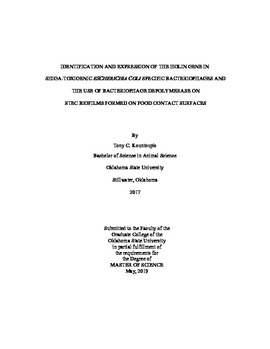| dc.contributor.advisor | Jaroni, Divya | |
| dc.contributor.author | Kountoupis, Tony C. | |
| dc.date.accessioned | 2020-01-30T19:46:47Z | |
| dc.date.available | 2020-01-30T19:46:47Z | |
| dc.date.issued | 2019-05 | |
| dc.identifier.uri | https://hdl.handle.net/11244/323413 | |
| dc.description.abstract | Shiga-toxigenic Escherichia coli (STEC) are one of the most common foodborne pathogens, responsible for numerous outbreaks of foodborne illness annually. The persistence of this group of pathogens makes them an incredible challenge to the food industry. This persistence is often attributed to the strong biofilm forming capabilities of STEC. The development of new control strategies against STEC and their biofilms would have significant benefits to the food industry. Bacteriophage by-products are an attractive intervention method for STEC control, particularly on food contact surfaces. One objective of this work was to evaluate the efficacy of a bacteriophage-derived depolymerase on STEC biofilms formed on food contact surfaces. The other objective of this work was to identify and express the bacteriophage holin gene in anticipation of further studies using the holin protein. Bacteriophage P9 was chosen for the depolymerase study due to its high level of lytic activity against E. coli O45, a known former of strong biofilms. To evaluate the effectiveness of phage depolymerase as a removal agent, stainless steel and high-density polyethylene surfaces were spot inoculated and biofilms were allowed to form for 48 hours before the treatments were applied with an airbrush. The effectiveness of phage depolymerase as a preventative was evaluated by applying the depolymerase with an airbrush before spot inoculating and allowing biofilm formation over 48 hours. The study indicated that phage depolymerase is effective at both removing and inhibiting biofilm formation on both stainless steel and high-density polyethylene surfaces, causing significant (P<05) reduction in STEC when compared to the control. In the holin study, phage J25 was chosen due to its high level of lytic activity against E. coli O145. Phage J25 was shown to contain the holin gene, and the gene was successfully cloned, sequenced, and expressed. Results indicated that phage depolymerase could be an effective method of biofilm inhibition and removal in the food industry. Results also indicated that the holin gene in bacteriophages can be expressed in order to produce the holin protein, which has the potential to be an effective STEC intervention method. | |
| dc.format | application/pdf | |
| dc.language | en_US | |
| dc.rights | Copyright is held by the author who has granted the Oklahoma State University Library the non-exclusive right to share this material in its institutional repository. Contact Digital Library Services at lib-dls@okstate.edu or 405-744-9161 for the permission policy on the use, reproduction or distribution of this material. | |
| dc.title | Identification and Expression of the Holin Gene in Shiga-Toxigenic Escherichia coli Specific Bacteriophages and the Use of Bacteriophage Depolymerase on STEC Biofilms Formed on Food Contact Surfaces | |
| dc.contributor.committeeMember | Jadeja, Ravi | |
| dc.contributor.committeeMember | Blewett, Earl | |
| osu.filename | Kountoupis_okstate_0664M_16458.pdf | |
| osu.accesstype | Open Access | |
| dc.type.genre | Thesis | |
| dc.type.material | Text | |
| dc.subject.keywords | bacteriophage | |
| dc.subject.keywords | biofilm | |
| dc.subject.keywords | depolymerase | |
| dc.subject.keywords | e. coli | |
| dc.subject.keywords | holin | |
| thesis.degree.discipline | Food Science | |
| thesis.degree.grantor | Oklahoma State University | |
